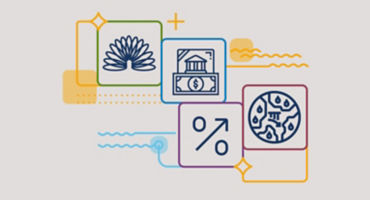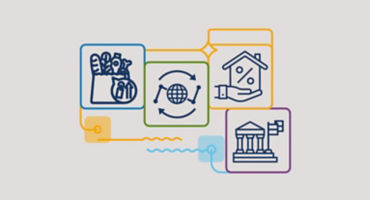- Macro Strategist
Skip to main content
- Funds
- Insights
- Capabilities
- About Us
- My Account
The views expressed are those of the author at the time of writing. Other teams may hold different views and make different investment decisions. The value of your investment may become worth more or less than at the time of original investment. While any third-party data used is considered reliable, its accuracy is not guaranteed. For professional, institutional, or accredited investors only.
While it’s not easy to assess today’s fast-moving and uncertain macro environment, from my perspective, it certainly fits the new regime’s mould of increased market and cycle volatility. So far this year, we’ve already oscillated between recession, a Goldilocks scenario, reflation and banking turmoil … and it’s only March. So where does this leave investors?
While the dizzying rate of change we’re currently facing may be atypical, a feature of the new regime is that cycles move more quickly through their different stages, with a much wider distribution of potential outcomes. It’s important, therefore, to be nimble and open-minded when considering the key questions that need to be addressed. In this instance, I think the two most important macro questions are:
There is little doubt that the challenges faced by the financial sector will adversely impact the real economy through tighter credit conditions and lower loan growth, at a time when real wages are already under pressure. Nonetheless, it’s too early to say with conviction what the likely outcome will be. Will tightening be contained and therefore simply act as a substitute for more rate hikes from the US Federal Reserve (Fed) and the European Central Bank (ECB)? Or will it become more pervasive and translate into a credit crunch that could push the economy into recession, and ultimately reintroduce deflation back into the distribution of potential outcomes?
While there is tentative evidence in the US and, to a lesser extent, Europe that some tightening may have already taken place, current data do not fully reflect the latest developments, and estimating the full magnitude of tightening will take time. For now, I expect markets to remain volatile and largely driven by headline news, particularly relating to the banking sector. However, I think the market’s focus is now shifting from inflation to recession, and as central banks pause to assess, the market will look to price the next move in rates as a cut rather than a hike.
There’s a risk that central banks may not act soon enough to prevent a deep recession given the accelerating cyclical backdrop, with a 40-year low in global unemployment and still-high inflation across most countries. However, I think the opposite is more likely. At the time of writing, the distribution of potential outcomes is exceptionally wide — with fat tails — and attaching probabilities to these outcomes is hard for policymakers. To the extent that history is a guide, it’s noteworthy that, in similar situations, policymakers have tended to set policy depending on which outcomes they wanted to avoid the most. Given the choice between financial instability — with the attendant risk of deflation — and inflation, central banks are likely to seek insurance against a scenario of financial instability and deflation, even though inflation remains very high.
After the recent hikes by the Fed and the ECB as well as the Bank of England, the Swiss National Bank and Norges Bank, we are starting to see signs that such a shift in policymakers’ thinking has begun. The Fed’s balance sheet is now expanding again and the ECB is making the outlook for rates explicitly conditional on how conditions in the financial system develop, while the Bank of Japan is no longer under pressure to abandon its yield curve control framework.
If tensions in the financial system persist, central banks may well cut rates in the second half of this year, despite the persistence of above-target inflation and high employment rates. Even a return to full stability in the financial system is now unlikely to lead to an automatic resumption of rate hikes as the hurdle for raising interest rates has become a lot higher than before the shock. Paradoxically, I think the current crisis has restored central bankers’ faith in monetary policy being able to achieve their goals, albeit with a lag, so they may be more inclined to wait to see the full effect of their policies. And even if the problems currently experienced by the banking sector are fully resolved, the shock has likely heightened concerns among policymakers that the financial system is now vulnerable to a sudden upward repricing of rates and that tightening comes with a higher cost.
We may be at the point where tightening credit conditions will drive a downturn without the need for more rate hikes. While cyclical inflation tends to fall during downturns, the recessions of the 1970s prove that this may not be sufficient to break structural inflation. The alternative scenario of a credit crunch and a deep recession would achieve that result, but regulators are unlikely to stomach such a scenario given the inherent risk of instability and deflation. The recent shock may well cement the path to embedding higher medium-term inflation, higher risk premia and higher long-term interest rates. However, to get to that point with any level of conviction, we first need to understand the recession risks ahead, which will be a key focus of our research.
Expert

How to nurture a growth mindset in a higher-yielding landscape
Continue readingState of the credit markets: Does cash rule everything around us?
Continue readingURL References
Related Insights
Stay up to date with the latest market insights and our point of view.

How to nurture a growth mindset in a higher-yielding landscape
In a higher-yield world, can fixed income deliver meaningful growth? John Mullins, Supriya Menon and Alex King explore how high-yield bonds may offer a powerful opportunity for growth - as well as a cushion against uncertainty.
The shifting liquidity landscape: What’s at stake?
The beginning of the end could be in sight for the Federal Reserve’s quantitative tightening (QT) program. US Macro Strategist Juhi Dhawan considers the Fed's next steps and what they could mean for banks, liquidity, and markets broadly.

US regional banking sector update
We explore how banking regulation and legislation could impact US regional banks, including highlighting the potential for M&A activity and for dispersion to drive long/short opportunities.

Financials amid rising dispersion
We explore why we believe dispersion across stocks, sectors, and geographies is supporting numerous secular themes in long/short investing in financials.
State of the credit markets: Does cash rule everything around us?
Fixed Income Portfolio Manager Brij Khurana outlines the state of the credit market today, compares historical periods of quantitative easing, and warns credit investors of cash scarcity in the near future.
FX outlook: Is USD exceptionalism withering away with the Fed hiking cycle nearing an end?
Discover the status of the USD today, learn where the greenback may be headed going forward, and understand why.

Private credit in a new regime
We explore how a shifting macro backdrop, ongoing banking crisis, and evolving competitive dynamics may create opportunities across private credit markets.

Global high yield: Attractive entry points could soon emerge
Fixed Income Portfolio Manager Konstantin Leidman shares his outlook for high-yield fixed income for the rest of this year and beyond.

Inflation loosens its grip, but bank turmoil could put the squeeze on US growth
US Macro Strategist Juhi Dhawan weighs the benefits of disinflation for consumers and companies against the risks of a credit crunch brought on by the recent bank crisis.

Credit market outlook: Expect greater opportunities in back half of 2023
Against a backdrop of elevated recession risks and banking-sector stress, Fixed Income Portfolio Manager Rob Burn identifies relative-value sector opportunities in the credit market.
Did the Fed just make a policy error?
Did the Fed just make a policy error? All things considered, Fixed Income Portfolio Manager Jeremy Forster thinks the answer is yes. Learn why and what the implications could be.
URL References
Related Insights